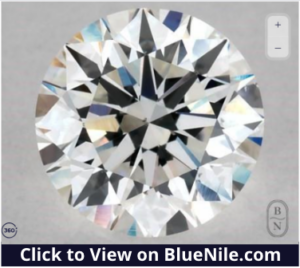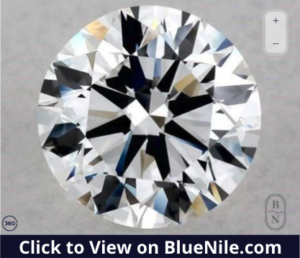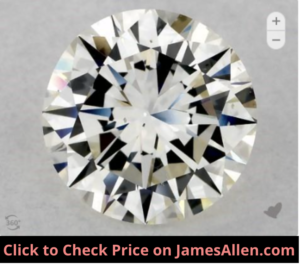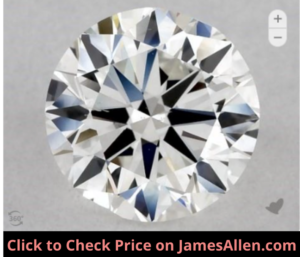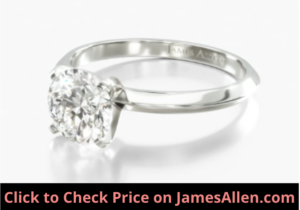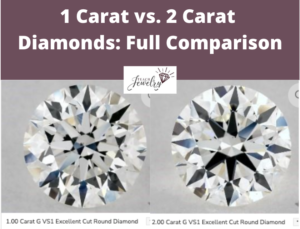
Diamonds are available in a range of carats, and it doesn’t have to be a round number.
But some buyers are interested in a one or two carat diamond and want to understand how the difference in weight affects its performance in an engagement ring.
The main differences between a 1 and 2 carat diamond is a 2 carat diamond has a larger surface area, and you’ll have to choose higher color and clarity grades for it to appear eye-clean. The price also substantially increases as you move from 1 to 2 carats.
We’ll provide a full comparison of 1 versus 2 carat diamonds, including:
- Sizes and proportions
- Cost
- Grades across the four Cs
- Settings
These factors will help you decide which is right for you.
Size, Proportions, and Dimensions
When someone refers to the size of a diamond, they typically aren’t referring to its dimensions or proportions, such as length and width, which is measured in millimeters.
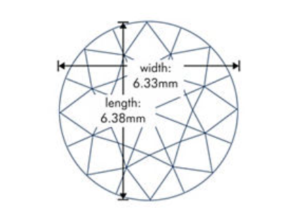
Instead, its size is a unit of weight called a carat, which equals 0.2 grams.
So a 1 carat diamond weighs 0.2 grams and a 2 carat diamond weighs 0.4 grams. The difference is 200 milligrams.
Carat weight is divided into 100 points.
If you’re searching for a diamond with a carat weight below two, they’re available at nearly every point between whole numbers. So your choice isn’t necessarily between those two numbers.
For example, you could choose a 1.30 or 1.45 carat diamond.
But it’s also worth noting the different dimensions between diamonds of various carat weights.
One carat diamonds generally have a 6.5mm diameter, but the exact measurement varies between diamonds.
For example, check out this round cut.
Its length is 6.34mm, and the width is 6.36mm.
As a comparison, this 1-carat round cut, from the vendor where I bought my wife’s engagement ring, is 6.22mm x 6.32mm.
To the naked eye, these distinctions aren’t apparent.
You might assume the dimensions of a 2 carat diamond are double that of a 1 carat, but that’s not the case.
Two carat diamonds often have diameters around 8mm.
The example below is 7.94mm – 8.04mm.
Similar to a 1 carat diamond, exact dimensions for 2 carat diamonds depend on the cut.
But the most common question is whether there’s an identifiable difference in size between 1 versus 2 carat diamonds when they’re viewed in a normal setting.
The answer is a 2 carat diamond is noticeably larger than a 1 carat diamond. If you’re most concerned about its appearance, the distinction won’t go unnoticed.
Prices
There are many traits that determine a diamond’s price, but carat weight is often the most impactful. You can expect an increase in cost with every point, but there are certain thresholds where there’s an even higher premium.
Additionally, the price of a diamond doesn’t increase linearly with carat weight. Instead, it’s exponential.
To create the chart below that shows how carat weight impacts diamond price, I analyzed prices for more than 500 diamonds with the same grades across clarity, cut, and color but different carat weights.
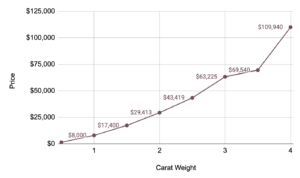
It demonstrates how two-carat diamonds are more than twice as expensive as one-carat diamonds.
To provide another example of this comparison, I examined prices for 291 1 and 2 carat diamonds from James Allen, a renowned online jeweler.
They had the following grades:
- Cut: Very good
- Shape: Round
- Color: G
- Clarity: VS2
The 1 carat diamonds cost an average of $5,642, with a range of $4,600-$6,050.
The 2 carat diamonds were priced at an average of $26,489. The range was $23,030-$32,750.
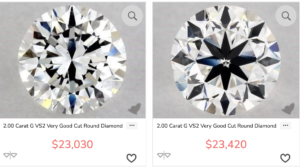
This demonstrates how 2 carat diamonds typically cost 3.5 to four times as much as 1 carat diamonds, even though the weight is only double.
In addition to the increase in price because of its weight, you may have to choose higher color and clarity grades for it to appear colorless and flawless without magnification.
Yellow tints or inclusions are often more apparent when the diamond is larger. This can also significantly increase the total price of a two-carat diamond.
Popularity in Engagement Rings
Jewelry vendor Ritani conducted research on the most popular carat weights for engagement rings.
The study found the average is 1.08 carats, with the range of 1.0 and 1.09 being the most common at 19 percent.
This demonstrates how 1 carat diamonds are more popular than 2 carats.
In fact, only four percent of diamonds in the survey weighed between 2.0 and 2.4 carats.
The Knot performed their own research and found the average is 1.5 carats, and only 25 percent are two carats or above.
The reason 1 carat diamonds are more popular for engagement rings compared to 2 carats is because of cost. Carat weight has one of the strongest correlations with cost, and as you’ve learned, it increases exponentially.
Diamonds close to 1 carat are often at the price most buyers are willing to spend, which is close to $5,000.
The research also found 10 percent of buyers choose a diamond slightly under 1 carat, between 0.90 and 0.99.
This is because there’s a premium when a diamond hits 1 carat, and it’s difficult to notice the difference in size between diamonds within 0.1 carats of each other.
Color Grades
The color of a diamond refers to the presence of any yellow or brown tints. Colorless diamonds are considered the most valuable, especially for engagement rings.
This quality is graded on a scale developed by the Gemological Institute of America (GIA), that includes five categories:
- Colorless (D-F)
- Near colorless (G-J)
- Faint (K-M)
- Very light (N-R)
- Light (S-Z)
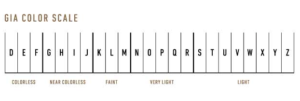
The exact color grades to consider depend on whether you’re choosing a 1 or 2 carat diamond. That’s because in your aim to find one that appears colorless to the naked eye, the size of its facets affect how color shows.
For example, I recommend starting your search with J color diamonds if it weighs one carat.
It’s the lowest position in the near colorless section, and you can find tremendous value if it’s graded J but appears identical to a D or F diamond in a normal setting.
Check out the comparison of two diamonds below.
On the left is an I color diamond, and on the right is one with an F grade.
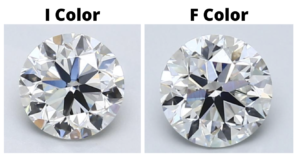
Even in those high-resolution images, they’re difficult to tell apart.
In fact, you can expect to save up to 50 percent by choosing a J or I diamond compared to one with a D color grade.
For a 2 carat diamond, start with the G-I range. It’ll likely have noticeable shades of yellow if you choose J or below because it’s faces and table are larger.
As an example, here’s a 2 carat diamond with a J color grade.
The hint of yellow is visible, especially compared to this G color diamond.
As with 1 carat diamonds, you’ll save on price by selecting a lower color grade, but it’ll appear the same as one with a colorless grade.
The key is not how it appears under 10x magnification but instead what it looks like to the naked eye.
One caveat on color grades is for fancy shapes with step-cut facets like Asscher or emerald cuts.
The examples below are both 2 carats and graded G, and the yellow isn’t visible.
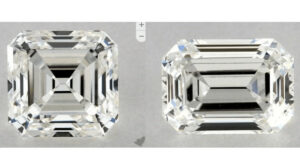
Their elongated facets tend to show more color, so you’ll have to choose higher grades compared to a round-cut.
Fortunately, they’re often less expensive than round-cuts, so the total price can even out.
Clarity
When comparing the clarity grades of 1 versus 2 carat diamonds, many of the same principles as deciding on color apply.
Clarity refers to the presence of inclusions, or blemishes, in a diamond’s facets.
There are many types, such as:
- Twinning wisps
- Feathers
- Clouds
- Etch channels
- Indented naturals
They’re present in diamonds of every size, from 1 or 2 carats and every weight below, above, and in between. They develop during its formation because of the intense heat and pressure.
The GIA clarity scale starts at flawless and ends at I3, where each grade below flawless conveys more impactful inclusions.
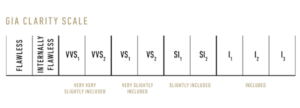
To find the best value, I recommend avoiding the highest grades. Your goal isn’t to find one without flaws visible at 10x magnification.
Instead, it’s best to find one that’s eye-clean and where inclusions don’t affect its durability or brilliance.
For example, I landed on a VS1 clarity diamond for my wife’s diamond because of the cost savings compared to ones in the VVS category. Everyone who has seen it thinks it’s flawless even though there are a few inclusions.
For 2 carat diamonds, start your search at VS1. View them in person or through high-quality images to learn if the inclusions are apparent.
For 1 carat diamonds, start searching at SI1. But if you want more certainty, move up to VS2.
This diamond provides a helpful example.
If you didn’t know its clarity was VS2, you’d think it was flawless. Even when you rotate the image, the inclusions are hard to find.
Cut
Cut is the factor that most affects a diamond’s brilliance and fire. The grade is a combination of several traits, such as proportions, symmetry, girdle thickness, and dimensions.
Cut grades for round-cut diamonds range from excellent to poor, with very good, good, and fair in between.
I recommend excellent cuts for one- and two-carat diamonds, as well as every other weight you’re considering for a center diamond.
You’ll maximize its light performance because even colorless and flawless grades won’t compensate for a poorly cut diamond.
Excellent cuts costs a premium. If you want to avoid that charge, the lowest you should ever go with is a “very good” grade.
Unlike color or clarity, it’s difficult to judge a diamond’s cut based on an image. Instead, read its report for the details.
I’ll walk you through the process for this 1 carat diamond.
In the second section of the left panel, you’ll find its grades across the four Cs. At the bottom, notice how its cut is excellent.
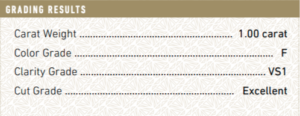
In the section below, you’ll find its polish and symmetry grades, which are excellent and very good, respectively.
The middle panel shows its proportions.
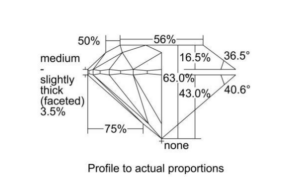
Based on this GIA report, I’m confident in the quality of its cut.
As a counter example, check out the cut grade of this 2 carat diamond.
Even though its polish is excellent, its symmetry is good and the girdle is medium – thick.
Despite its strong color and clarity grades, its cut would result in a slight lack of brilliance.
Settings
Once you’ve decided on a 1 or 2 carat diamond, it’s time to select the perfect setting.
There are many styles available, and almost all fit both carat weights. But there are factors to consider because of their different dimensions.
If you’re paying the premium for a 2 carat gem, you want to show it off. That’s why you might choose a high setting, where the diamond sits far above the ring to collect and return the most light.
Solitaire settings are also a popular choice for large diamonds. They allow you to best display the gem, without smaller diamonds on the ring detracting from it.
For example, check out this 2 carat diamond in a knife edge setting.
The thin band causes the diamond to appear even larger. It’s a striking combination that focuses all the attention on the center stone.
For 1 carat diamonds, it’s common to opt against solitaires and instead choose a setting with additional diamonds in the form of pave or a halo.
The halo creates an illusion of a heavier diamond because from a distance, they blend together.
There’s also pave on the shank, which means the piece will sparkle from every angle.
Whether you land on a diamond that weighs 1 or 2 carats, pair them with several types of settings to learn which style fits your taste.
On the websites of many online jewelers, they allow you to mix and match cuts and settings to learn which style you prefer. It’s how I chose my wife’s engagement ring, because I could test dozens of combinations before landing on a knife edge solitaire piece.
How to Decide Between a 1 or 2 Carat Diamond
Comparing 1 carat versus 2 carat diamonds involves understanding how their weights impact the rest of its qualities.
Here are some tips to help you choose.
Consider a 1 carat diamond if:
- You want to save a significant amount on cost compared to 2 carats
- You’re choosing a setting that features other diamonds and aren’t concerned that it may detract from its prominence
- You plan to put that savings toward higher clarity, cut, or color grades or a more elegant setting
A 2 carat diamond might be right for you if:
- You’re willing to pay a premium for a larger diamond
- When choosing its color and clarity, you select high enough grades that it still appears flawless and colorless to the naked eye
- You’re interested in placing it in a solitaire setting, where it commands the most attention
Explore 1 and 2 carat diamonds at in-person and online jewelry retailers.
By pairing them with various settings, you’ll create the right diamond ring for you.

Jacob Clarke
Jacob Clarke is the founder of TeachJewelry.com.
He earned an Applied Jewelry Professional Diploma from the Gemological Institute of America (GIA) and now brings you essential information about diamonds, settings, and more.
Jacob has consulted with leading jewelry brands, and his work has been cited in Clean Origin, Diamond Nexus and industry publications.
He's also a member of the International Gem Society.
He enjoys discussing jewelry with readers, so contact him with any questions at jacob.clarke@teachjewelry.com.

